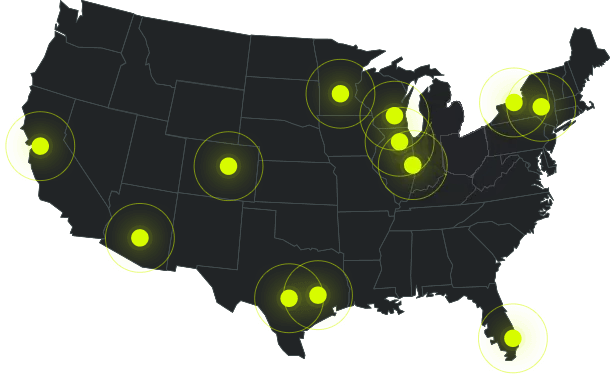Additional Material Notes / / If color matching needs to be exact, Fathom often recommends doing a first article even though it will extend the timeline. If a color or assembly match needs to be made for other parts, a sample part is recommended to confirm color match. Parts can be molded in glossy or matte finish—please specify in quote request. If Shore A needs to be exact, Fathom recommends a first article, as well as casting in a .25″ thick test slug for durometer measurement. This may add to the timeline, however, this extra time investment will ensure accurate part delivery.
Need A Material Not Listed? Speak With A Fathom Expert Directly.
Urethane Casting Parts in As Soon As One-Week / / Get A Quote
Advantages of Urethane Casting / /
Before choosing urethane casting for your project, it is important to note the advantages.
Advantages of urethane casting include //
- Different Colors, Textures & Finishes May Be Used
- Wide Variety of Material, Both Rigid & Flexible Options
- Finer Details Can Be Accomplished
- Varying Wall Thickness
- Reduced Lead Times, Faster to Market
- Higher Level of Detail Than Traditional Manufacturing Methods
- Higher Quality Production Parts at Lower Volumes
- Accurate Testing to Ensure Part Accuracy Before Production
- Casted Part Can Include Threaded Inserts, Adding Strength To The Part
- 3D Printed Master Patterns & Silicone Mold Tooling
Common Applications of Urethane Casting / /
Many industries use urethane casting for their prototype and production projects. Urethane casting can be a smart choice for a lower-quantity project as investing in injection mold tooling can be expensive. Another advantage of urethane casting is that it is optimal for use as a first production run, serving as a cost-saving measure to test prototypes before larger-scale production. Advanced prototyping is also feasible with urethane casting because the tooling and design changes cost less than with other manufacturing methods. It is also possible to test a variety of materials from a single mold. Parts made using urethane casting can also be used for customer testing given the high aesthetic quality.
Urethane Casting Applications //
- Test Prototypes
- Rapid Prototypes
- Exhibit Parts
- Consumer Testing
- Products for Crowdfunding
- Lower-Volume Manufacturing
- Concept Models
- Sales Samples
- Engineering Models
- Marketing Test Samples
- Pre-Production Runs
- Bridge to Production Parts
- Point of Purchase Displays
- Conveyor Systems
- Medical Devices
- Specialty Over-Molding
- Aircraft Interior Components
Urethane Casting vs. 3D Printing / /
Both urethane casting and 3D printing are popular manufacturing methods for producing a lower volume of parts. 3D printing is an additive manufacturing process that begins with a CAD design and then uses a machine to build the piece in layers. In urethane casting, the master mold is first produced, usually by a 3D printing method, then the mold is used to create a cavity of the product in silicone. Urethane or other liquid resin is poured into the cavity to form the part. When it comes to selecting a material, there are limitations with both methods. 3D printing does allow for a broader range of plastic and metal material. The material used for urethane casting is limited to rubber or plastic that will cure at room temperature. 3D printing is an excellent choice for prototyping and intricate, iterative designs as well as for creating replicas. Each method has different capabilities and costs, each having its own unique advantage depending on project needs.
Urethane Casting vs. Injection Molding / /
There are a number of differences between urethane casting and injection molding that may determine which method is best for your project. Injection molding is more expensive than urethane casting. Injection molding tooling can cost thousands to tens of thousands of dollars, whereas urethane casting costs range from hundreds to thousands. Injection molding uses a real plastic material, but urethane molding uses polyurethanes, which simulate the plastic used in injection molding. Both processes can be used for over-molding onto plastic or metal parts. One of the most substantial differences is volume. Injection molding can be used to create a prototype, bridge and high-volume production in the thousands. Urethane casting is best for prototype, bridge and production parts in the hundreds.
Urethane Casting Parts in As Soon As One-Week / / Get A Quote
Urethane Casting FAQs / /
Q // What Is The Maximum Size For a Urethane Cast Part?
A // Larger parts can be reviewed by the project to determine size capabilities.
Q // How Many Parts Can You Produce From A Single Mold?
A // On average, up to 25 parts. If the design includes many sharp edges, this may cause the mold to deteriorate more quickly.
Q // How Is The Silicone Mold Tool Made?
A // First, a design is created using CAD software or a model is provided by the client. A 3D printed master model is created and then encased in silicone rubber. Once the silicone has cured, the master model is removed. The cavity left behind is the mold tool.
Q // Can Urethane Cast Parts Be Used For Final Products?
A //While urethane casting is popular for rapid prototyping, this method can be used as a bridge tooling process to get the product to market for testing during simultaneous production tooling. It is also perfect for final products when the quantity needed is low-to-medium.
Q // Will I Sacrifice Appearance By Choosing Urethane Casting?
A // No, Fathom will work with you to ensure your parts are high quality and aesthetically accurate.
Q // What Is Another Term For Urethane Casting?
A // Urethane casting is sometimes referred to as urethane molding.
Get a Urethane Casting Quote / /
Quickly get a quote in as soon as one hour on any urethane casting project today with our SmartQuote platform.









